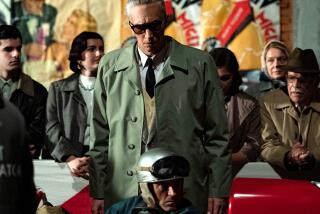Auto museum displays the crème of the crop
- Share via
Outside, it’s just another building in an Oxnard office park — though it’s the only one flying the flags of the U.S. and France.
Inside, it’s an homage to automotive luxury, an assemblage of French Art Deco cars of the 1930s and 1940s with such fabled names as Hispano-Suiza, Delahaye and Delage.
They are the kind of cars that cost small fortunes and inspire great passions. As the British actor and bon vivant Peter Ustinov put it: “One, of course, drives an Alfa Romeo and one is driven in a Rolls-Royce, but one gives only a Delage to one’s favorite mistress.”
In the building once used by the late Times publisher Otis Chandler for his collection of muscle cars and hunting trophies, a Los Angeles philanthropist named Peter Mullin is offering jaw-dropping views — by appointment only, at https://www.mullinautomotivemuseum.com — of French luxury cars and furnishings of a certain age.
Opened last month, the Mullin Automotive Museum displays more than 100 rare vehicles, mostly with bodies custom-made by French carriage builders.
These are not the sort of vehicles into which madame plops the kids in the back seat and a Slurpee in the drink holder. More likely, they ferried archdukes and Russian wolfhounds.
For the outdoorsman who likes to travel in style, there’s a pale green 1937 Hispano Suiza as big as the Ritz, with buffalo-hide upholstery and sea grass floor mats. Known as a ‘shooting brake,’ it was “designed for the well-heeled to carry large amounts of cargo such as dogs and hunting guns for grouse shooting,” according to a display placard.
Slowly rotating on a turntable, a wine-red 1939 Delahaye Type 165 cabriolet is all swoops and slopes and voluptuous curves, a reclining nude with a 12-cylinder engine.
“There’s definitely something sensual, something sculptural here,” said Mullin, 69, a tall, white-haired man who made his money in insurance and as a consultant on executive compensation and benefits. “When I saw my first French car, I was shocked by how gorgeous it was. I was intrigued, I was fascinated, I was smitten.”
Mullin tore down and rebuilt the engine of a 1953 Chevy Bel Air when he was 16, but was left with a big box of parts that didn’t quite seem to fit anywhere. He said the car ran just fine until he sold it eight years later. Now, seasoned artisans do the restorations on his collection, which he started about 30 years ago.
Later this year, the museum may display a rare 1936 Bugatti Type 57SC Atlantic, according to curator Andrew Reilly. Reportedly selling last week for $30 million to $40 million, the car is far and away the world’s most expensive, according to the Wall Street Journal.
But Reilly denied the Journal’s report that the museum had purchased the car, saying that its new, anonymous owner merely had been in talks with Mullin about exhibiting it.
In any event, Mullin, showing a visitor around his museum, had no hesitation about pointing out his favorite car: the droplet-shaped burgundy 1938 Talbot-Lago T 150 CS coupe. Bending down and squinting, he beheld it and declared, as he has many times, that there isn’t a
“bad angle” — or, for that matter, a right angle — anywhere to be seen.
“It’s perfection,” he said. “It’s like a raindrop that travels through the sky. It’s the perfect aerodynamic form.”
The stories behind the cars are as impressive as their looks.
Racing cars line a portion of the museum’s second floor. One of them — a 1937 Delahaye 145 — was disassembled and buried in a French hillside to keep it from the Nazis during the invasion of France. It had been built for a million-franc prize the French government offered to any racer who could beat Germany, which had nationalized its auto industry. Adolf Hitler was particularly enraged that the Delahaye had been piloted to victory over German and Italian cars at several races by a well-known Jewish driver, Rene Dreyfus.
Some Bugattis on the museum floor gleam, but some, very deliberately, do not. One black 1936 coupe comes complete with cracked red leather, peeling paint, and large patches of rust.
Reilly said some cars have been left unrestored as a tribute to their history.
A tourist from Montreal said he was moved when he spotted the old car he owned as a student in Paris.
“He said it had the same smell, the same look, the same feel. He said he was so poor then he could only afford to drive it from one parking space to another,” Reilly said.
Then there’s the rusted chassis of a 1925 Bugatti Brescia, a relic dredged up in 2009 after 70 years beneath the chill waters of Lake Maggiore in Switzerland. A Swiss playboy won it in a Parisian poker game — but he was down on his luck and couldn’t afford the stiff import duties required to bring it back home. That’s when Swiss officials sunk it, saying the law required them to do so.
When it was hauled up before a crowd of 2,000, its two remaining tires were still inflated and its dashboard instruments were intact. Much of the body was rusted through, but the part that was buried in mud had the look of an Impressionist canvas, its original blue paint job speckled with browns and greens.
“It’s the beauty from the deep,” Mullin said as he stood before it. “You can’t possibly improve on it. How could you replace that patina?”
More to Read
Sign up for The Wild
We’ll help you find the best places to hike, bike and run, as well as the perfect silent spots for meditation and yoga.
You may occasionally receive promotional content from the Los Angeles Times.







